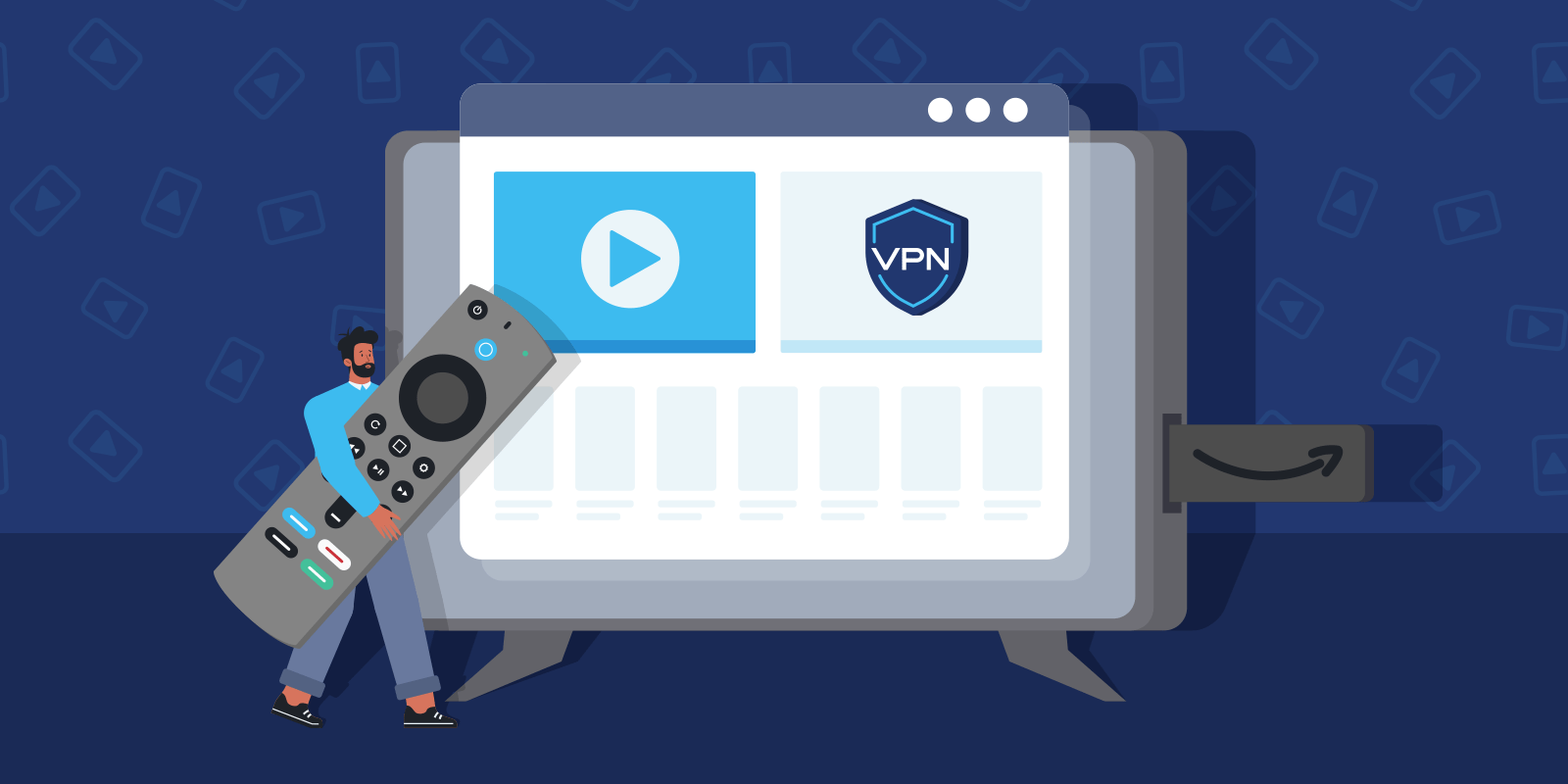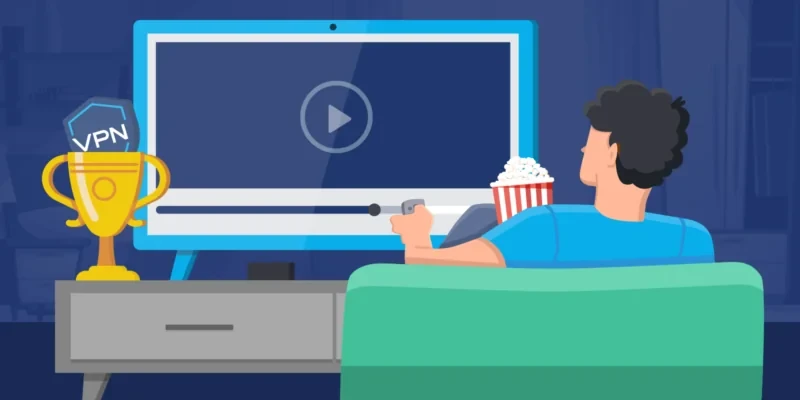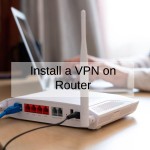In today's digital age, our TVs are more than just devices for watching shows and movies. With the rise of streaming services and smart TVs, they have become powerful entertainment hubs that connect us to a world of content. However, accessing geo-restricted content, ensuring privacy, and securing internet connections on TVs can be challenging without the right tools. This is where a Virtual Private Network (VPN) comes in. In this comprehensive guide, we will delve into the process of installing and using a VPN on your TV, empowering you to unlock a world of content while safeguarding your privacy and security.

Installing VPN on TV
In the digital era, where privacy and security are paramount, using a VPN on your TV has become increasingly important. A VPN not only allows you to access geo-restricted content but also encrypts your internet connection, protecting your data from prying eyes. Installing a VPN on your TV opens up a world of possibilities, from streaming your favorite shows to accessing content from around the globe. In this guide, we'll explore the step-by-step process of installing a VPN on your TV, covering everything from choosing the right VPN provider to configuring it for optimal performance.
Understanding VPN Download
The first step in installing a VPN on your TV is to find the appropriate vpn download client. Whether you have an Android TV, Apple TV, or a Smart TV, there are VPN apps available for various platforms. It's essential to choose a reputable VPN provider with a user-friendly app and robust security features. Take your time to research and select a VPN provider that meets your needs and preferences. Once you've chosen a provider, download the VPN app from the respective app store or the provider's website.
Exploring Best Free VPN Options
While paid VPN services offer premium features and better performance, there are also best free vpn options available for those on a budget. These free VPNs may come with limitations such as slower speeds, data caps, or fewer server locations. However, they can still provide basic privacy and security benefits. Some popular free VPNs for TVs include ProtonVPN, Windscribe, and TunnelBear. Before making a decision, carefully review the features and limitations of each free VPN option to ensure it meets your requirements.
Choosing the Right VPN App
Choosing the right VPN app is crucial for a seamless and secure browsing experience on your TV. Consider factors such as compatibility with your TV platform, ease of use, and available features. Some popular vpn app for TVs include ExpressVPN, NordVPN, and Surfshark. These apps offer user-friendly interfaces, strong encryption protocols, and a wide range of server locations. Take your time to explore the features of each app and choose the one that best suits your needs.
Accessing VPN Gateway
Once you've chosen a VPN app and downloaded it on your TV, the next step is to access the VPN gateway. The VPN gateway acts as an entry point to the VPN server network and allows you to establish a secure connection. Open the VPN app on your TV and log in with your credentials. Then, choose a server location from the list of available options and connect to the VPN gateway. It's essential to select a server location that aligns with your content preferences and streaming needs.
Utilizing VPN Online
Using a VPN on your TV offers numerous benefits, including accessing geo-restricted content, protecting your privacy, and securing your internet connection. With a VPN, you can bypass geographic restrictions and access content from around the world. Additionally, a VPN encrypts your internet connection, preventing third parties from monitoring your online activity. This is particularly important when using public Wi-Fi networks or streaming content from unfamiliar sources.
Exploring VPN Free Download Options
For those looking to save money, there are several vpn free download options available for TVs. These free VPNs may come with limitations such as slower speeds or data caps, but they can still provide basic privacy and security benefits. Some popular free VPNs for TVs include ProtonVPN, Windscribe, and TunnelBear. Before choosing a free VPN, carefully review the features and limitations to ensure it meets your requirements.
Downloading VPN App for TV
Downloading a VPN app for your TV is a straightforward process that can be completed in just a few steps. Visit the app store on your TV platform and search for the VPN app of your choice. Once you've found the app, click on it to begin the vpn app download and installation process. Follow the on-screen instructions to install the app on your TV. Once the app is installed, you can launch it and log in with your credentials to start using the VPN.
Using VPN Application
Using a VPN application on your TV is easy and straightforward. Once you've downloaded and installed the app, launch it from your TV's home screen. Log in with your credentials, if prompted. Then, choose a server location from the list of available options and connect to the VPN. Once connected, you can browse the internet securely and access geo-restricted content from around the world. It's essential to keep the VPN app updated to ensure you have access to the latest features and security updates.
Benefits of VPN Free for TV
Using a free VPN on your TV offers several benefits, including cost savings and accessibility. While free VPNs may come with limitations such as slower speeds or data caps, they can still provide basic privacy and security benefits. Some popular free VPNs for TVs include ProtonVPN, Windscribe, and TunnelBear. Before choosing a free VPN, carefully review the features and limitations to ensure it meets your requirements.
Free VPN for TV
There are several vpn free options available for TVs, each with its own set of features and limitations. Some popular free VPNs for TVs include ProtonVPN, Windscribe, and TunnelBear. These VPNs offer basic privacy and security benefits, but they may come with limitations such as slower speeds or data caps. Before choosing a free VPN, carefully review the features and limitations to ensure it meets your requirements.
VPN for TV Features and Benefits
Using a vpn online on your TV offers several features and benefits, including:
- Access to geo-restricted content: With a VPN, you can bypass geographic restrictions and access content from around the world.
- Privacy and security: A VPN encrypts your internet connection, preventing third parties from monitoring your online activity.
- Secure internet connection: A VPN protects your data from hackers and other cyber threats, ensuring a safe and secure browsing experience.
- Anonymity online: With a VPN, your IP address is masked, making it difficult for websites and advertisers to track your online activity.
Configuration of VPN on TV
While most VPN providers offer dedicated apps for TVs, some users may prefer to manually configure their VPN connection. This involves entering the VPN server details, such as server address and authentication credentials, into the TV's settings. While manual configuration offers greater control over VPN settings, it may be more challenging for less experienced users.
Advantages of VPN for TV
Using a VPN on your TV offers several advantages, including:
- Access to geo-restricted content: With a VPN, you can bypass geographic restrictions and access content from around the world.
- Enhanced privacy and security: A VPN encrypts your internet connection, preventing third parties from monitoring your online activity.
- Secure internet connection: A VPN protects your data from hackers and other cyber threats, ensuring a safe and secure browsing experience.
- Anonymity online: With a VPN, your IP address is masked, making it difficult for websites and advertisers to track your online activity.
How to Set Up Install VPN on TV
Setting up a VPN on your TV may seem daunting at first, but with the right guidance, it's a straightforward process. Here's a step-by-step guide to help you get started:
Choose the Best VPN Right Now: Before installing a VPN on your TV, it's crucial to select a reliable VPN provider. Look for features such as strong encryption, a wide server network, and compatibility with your TV platform.
Easy Way to Install Install VPN on TV: Most VPN providers offer dedicated apps for popular TV platforms such as Android TV, Apple TV, and Smart TVs. Simply download the VPN app from the app store on your TV and follow the on-screen instructions to install it.
Configuration Install VPN on TV: Once the VPN app is installed, open it and log in with your credentials. Choose a server location from the available options and connect to the VPN.
Automatic Configuration Install VPN on TV: Many VPN apps offer automatic configuration options, making it even easier to set up a VPN on your TV. Simply enable the automatic configuration feature in the app settings, and the app will select the best server for you.
Manual Configuration Install VPN on TV: For advanced users, manual configuration options are also available. This allows you to specify the server location and customize other settings according to your preferences.
Best VPN Right Now
When it comes to selecting the best VPN for your TV, there are several factors to consider. Some of the top VPN providers in the market right now include:
- ExpressVPN: Known for its fast speeds, strong encryption, and user-friendly interface.
- NordVPN: Renowned for its extensive server network, excellent security features, and reliable performance.
- Surfshark: A budget-friendly option with unlimited simultaneous connections and robust privacy protections.
Consider your specific needs and preferences when choosing a VPN provider for your TV.
Easy Way to Install Install VPN on TV
Installing a VPN on your TV is easier than you might think. Most VPN providers offer dedicated apps for popular TV platforms, making the installation process a breeze. Simply follow these steps:
Download the VPN App: Go to the app store on your TV platform and search for the VPN app of your choice.
Install the VPN App: Once you've found the app, click on it to begin the download and installation process.
Launch the VPN App: After the app is installed, launch it from your TV's home screen.
Log in: Log in to the VPN app using your credentials. If you don't have an account, you'll need to sign up for one first.
Connect to a Server: Choose a server location from the list of available options and connect to the VPN. Once connected, you'll be able to access geo-restricted content and browse the internet securely on your TV.
Configuration Install VPN on TV
Configuring a VPN on your TV involves selecting the appropriate settings to ensure a secure and reliable connection. Here are some key configuration settings to consider:
- Protocol: Choose the VPN protocol that best suits your needs, such as OpenVPN or IKEv2.
- Encryption: Select the level of encryption for your VPN connection, with AES-256 being the most secure option.
- Server Location: Choose a server location that aligns with your content preferences and streaming needs.
Automatic Configuration Install VPN on TV
Many vpn application offer automatic configuration options, which make it easier to set up and manage your VPN connection. Here's how to enable automatic configuration on your TV:
Open the VPN App: Launch the VPN app on your TV.
Navigate to Settings: Go to the settings or preferences menu in the VPN app.
Enable Automatic Configuration: Look for an option labeled "Automatic Configuration" or "Auto Connect" and toggle it on.
Choose Preferred Settings: Some VPN apps allow you to specify your preferred settings for automatic configuration, such as server location and protocol.
Save Changes: Once you've configured automatic settings to your liking, save your changes and exit the settings menu. Your VPN app will now automatically connect to the best available server whenever you launch it.
Manual Configuration Install VPN on TV
For users who prefer more control over their VPN connection, manual configuration options are also available. Here's how to manually configure a VPN on your TV:
Open Network Settings: Go to the network settings menu on your TV.
Add a VPN Connection: Look for an option to add a new VPN connection and select it.
Enter Connection Details: Enter the necessary connection details, including the VPN server address, connection name, and authentication credentials.
Configure Advanced Settings: Optionally, you can configure advanced settings such as VPN protocol, encryption, and DNS settings.
Save Changes: Once you've entered all the necessary information, save your changes and exit the settings menu. Your VPN connection is now configured and ready to use.
Why and When to Use Install VPN on TV
There are several reasons why you might want to use a VPN on your TV:
- Access Geo-Restricted Content: A VPN allows you to bypass geographic restrictions and access content that may be blocked or restricted in your region.
- Protect Your Privacy: A VPN encrypts your internet connection, preventing third parties from monitoring your online activity.
- Secure Your Internet Connection: A VPN protects your data from hackers and other cyber threats, ensuring a safe and secure browsing experience.
- Anonymize Your Online Activity: With a VPN, your IP address is masked, making it difficult for websites and advertisers to track your online activity.
As for when to use a VPN on your TV, consider using it whenever you want to access geo-restricted content, enhance your privacy, or secure your internet connection while streaming.
Facts on how to install vpn on tv
Here's a detailed comparison of how to install a VPN on TV across various aspects.
Native VPN Support:
- Some smart TVs, particularly those running Android TV or certain other operating systems, may have native support for VPN installation. This allows users to directly install and configure VPN apps from the TV's app store or settings menu.
Router Configuration:
- Many VPN providers offer support for configuring VPN connections at the router level. By setting up the VPN on your router, all devices connected to the router, including your TV, will automatically be routed through the VPN connection.
Casting/Mirroring:
- If your TV does not support native VPN installation and your router does not support VPN configuration, an alternative method is to cast or mirror content from a device with an active VPN connection to the TV. This allows you to access geo-restricted content on your TV by streaming from a VPN-enabled device.
Ease of Installation:
- Native VPN Support: Generally easy to install directly from the TV's app store or settings menu, similar to installing apps on a smartphone.
- Router Configuration: Requires technical knowledge to configure VPN settings on the router, including knowledge of router models, firmware, and VPN protocols.
- Casting/Mirroring: Relatively easy to set up, but requires a separate device with a VPN connection and may introduce additional lag or quality issues during streaming.
Compatibility:
- Native VPN Support: Limited to smart TVs that offer native support for VPN installation, typically those running Android TV or similar operating systems.
- Router Configuration: Compatible with most modern routers that support VPN configuration, regardless of the TV's operating system or brand.
- Casting/Mirroring: Compatible with any TV that supports casting or mirroring from external devices, such as Chromecast, AirPlay, or Miracast.
Security and Privacy:
- Native VPN Support: Offers encryption and privacy protection directly on the TV, ensuring secure browsing and protection against third-party monitoring.
- Router Configuration: Provides encryption and privacy protection for all devices connected to the router, including the TV, but may require manual configuration of VPN settings and periodic firmware updates for security patches.
- Casting/Mirroring: Relies on the security and privacy features of the device with the active VPN connection, with the TV acting as a display for the mirrored content.
Performance:
- Native VPN Support: Performance may vary depending on the TV's hardware specifications and the VPN provider's server network.
- Router Configuration: Performance depends on the router's processing power, internet connection speed, and the quality of the VPN service.
- Casting/Mirroring: Performance may be affected by the capabilities of the casting/mirroring device, the strength of the Wi-Fi connection, and any potential lag introduced during streaming.
Cost:
- Native VPN Support: Free if the TV offers native VPN support and the VPN app is available for free in the TV's app store.
- Router Configuration: Requires a subscription to a VPN service, which may have varying costs depending on the provider and the chosen plan.
- Casting/Mirroring: Costs may include the purchase of a separate device with VPN support, such as a smartphone, tablet, or streaming device, as well as any associated subscription fees for VPN services.
Why Should You Use Install VPN on TV
There are several benefits to using a VPN on your TV:
- Access to Geo-Restricted Content: With a VPN, you can access content from around the world that may be blocked or restricted in your region.
- Enhanced Privacy: A VPN encrypts your internet connection, protecting your data from hackers, government surveillance, and other online threats.
- Secure Internet Connection: A VPN secures your internet connection, ensuring that your personal information and browsing activity remain private and secure.
- Anonymity Online: With a VPN, your IP address is masked, making it difficult for websites and advertisers to track your online activity.
Using a VPN on your TV offers peace of mind knowing that your online activities are protected and your privacy is safeguarded.
How to Get a Install VPN on TV
Getting a VPN on your TV is easy and straightforward. Simply follow these steps:
Choose a VPN Provider: Research and select a reputable VPN provider that offers a dedicated app for your TV platform.
Download the VPN App: Go to the app store on your TV platform and search for the VPN app of your choice.
Install the VPN App: Once you've found the app, download and install it on your TV.
Launch the VPN App: After the app is installed, launch it from your TV's home screen.
Log in: Log in to the VPN app using your credentials. If you don't have an account, you'll need to sign up for one first.
Connect to a Server: Choose a server location from the list of available options and connect to the VPN. Once connected, you'll be able to enjoy a secure and private browsing experience on your TV.
Advantages and Benefits of Install VPN on TV
Using a VPN on your TV offers numerous advantages and benefits, including:
- Access to Geo-Restricted Content: With a VPN, you can access content from around the world that may be blocked or restricted in your region.
- Enhanced Privacy: A VPN encrypts your internet connection, protecting your data from hackers, government surveillance, and other online threats.
- Secure Internet Connection: A VPN secures your internet connection, ensuring that your personal information and browsing activity remain private and secure.
- Anonymity Online: With a VPN, your IP address is masked, making it difficult for websites and advertisers to track your online activity.
Installing a VPN on your TV is a simple and effective way to access geo-restricted content, enhance your privacy, and secure your internet connection while streaming. By following the steps outlined in this guide and choosing a reputable VPN provider, you can enjoy a safe, secure, and private browsing experience on your TV. Whether you're streaming your favorite shows or browsing the web, a VPN offers peace of mind knowing that your online activities are protected and your privacy is safeguarded.
Commonly Asked Questions and Answer
Here are commonly asked questions and answers regarding how to install a VPN on TV.
Q Can I install a VPN directly on my TV?
- It depends on the type of TV you have. Some smart TVs, particularly those running operating systems like Android TV, may have built-in support for installing VPN apps. You can check the app store or settings menu on your TV to see if VPN apps are available for installation.
Q How do I install a VPN on my TV if it doesn't support it natively?
- If your TV does not support native VPN installation, you have a few alternative options:
- Router Configuration: Set up the VPN on your router instead. This way, all devices connected to the router, including your TV, will automatically use the VPN connection.
- Casting/Mirroring: Cast or mirror content from a device with an active VPN connection (such as a smartphone or computer) to your TV. This allows you to access content from the VPN-enabled device on your TV screen.
Q Can I use a free VPN on my TV?
- Yes, you can use a free VPN on your TV if you find one that supports your TV's operating system. However, free VPNs often come with limitations such as data caps, slower speeds, and fewer server locations. Additionally, free VPNs may not offer the same level of privacy and security as paid VPN services.
Q Do I need technical knowledge to install a VPN on my TV?
- It depends on the method you choose. Installing a VPN app directly on your TV, if supported, is usually straightforward and similar to installing apps on a smartphone. However, configuring a VPN on your router may require some technical knowledge, as it involves accessing the router's settings and entering VPN configuration details.
Q Can I install a VPN on any type of TV?
- VPN installation options vary depending on the type and model of your TV. Generally, smart TVs with operating systems like Android TV or webOS are more likely to support native VPN installation. Older or basic TVs may not have built-in VPN support, but you can still use alternative methods like router configuration or casting/mirroring.











